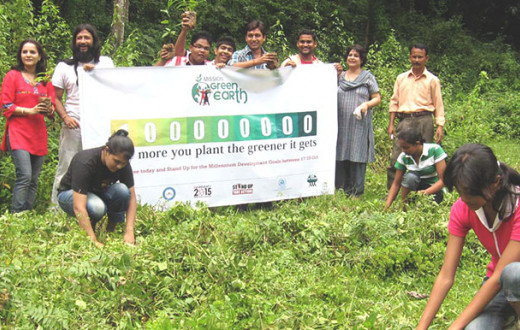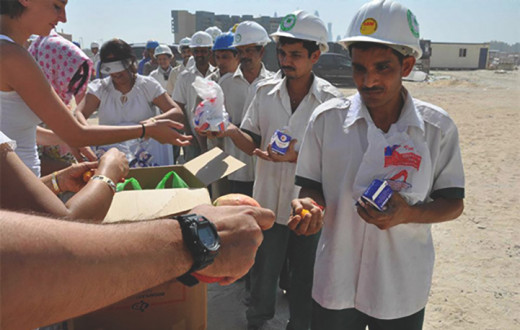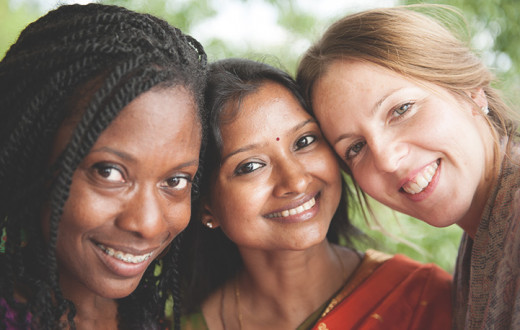“Ithe shetkari karjathach janmatho aani karjathach maran paavatho.” (Here farmers are born in debt and die in debt) – Old Marathi saying
One thousand nine hundred and twenty* farmers committed suicide in Maharashtra between January 2001 and August 2006, according to government figures. Unofficial figures put it at three times that number; between 2005 and 2006, there was reported to be one death every eight hours. Most of these were in the region of Vidarbha, the cotton belt of Maharashtra.
The cotton sowing season in Vidarbha falls just before the monsoon, when the air is thick with moisture and anxiety. Cotton, also called “white gold”, is a crop that needs water at exactly the right times and in the right amounts. If the monsoon came too early or too late, it would mean a below par crop: lesser earnings for a farmer who was already struggling.
Much of Vidarbha is rocky terrain and hilly jungles, and if not for a generous monsoon, unsuitable for farming. For the 3.2 million farmers here, growing cotton is a high-risk operation. Their dependence on cotton means a huge investment in seeds and insecticides, and overdependence on a finicky monsoon.
A few years ago, multi-national companies peddling genetically modified seeds began marketing in rural India, including the interiors of Vidarbha. For centuries, farmers have grown their own seeds, but since 2002, genetically modified cotton seeds, called “BT” have been marketed vigorously. BT promises better yield and more resistance against pests, but needs a significantly larger amount of irrigation – dependable irrigation that is available only on 3% of the cotton farms across Vidarbha*. The BT seeds also need a specific brand of insecticide, which, incidentally, is also marketed by the same MNC at high cost.
Whereas traditional organic seeds can be home-grown, BT seeds cannot; farmers who plant BT have to buy the expensive seeds every year to be able to sustain their returns. Changing from BT to traditional seeds is also not possible, as BT seeds have flooded the market and traditional seeds are no longer available.
Despite this, farmers are lured by the promise of higher returns and a hardy seed, and pay huge amounts to buy hybrid seeds. Since they don’t have enough capital to make the initial investment, they take loans from government banks.
Much of Vidarbha is illiterate. Most people here use their thumb prints to sign the hundreds of forms required by a lumbering Indian bureaucracy. Banks also mean that farmers get much lesser than what they really need; money that has to be used not only for seeds, fertilizer and pesticide, but also for labor, and for household expenses.
The sahukar (private lender) has long been a feared figure in India. Most often he is portrayed as a well dressed, portly man enjoying the luxury of money without having to move a muscle. Often, sahukars offer easy money to borrowers; instead of the hundreds of forms to be signed in the bank, the sahukar needs only one “stamp paper” – paper usually used for financial contracts, and that can be produced in the court of law as evidence.
The farmers do not hesitate to put their thumb print on a blank sheet of paper as long as the sahukar gives them the amount they ask for. They do not know what they risk: the possibility that the money lender will take over their land.
Once the money is lent, unscrupulous sahukars can impose any amount of interest on the farmers. Sometimes the rate of interest is 100%; sometimes 200%; often they then proceeded to confiscate the man’s land.
With no one to turn to, the farmers commit suicide.
Most suicides happen at dawn, just as farmers begin their day’s work. Most often, they use the same expensive insecticide sold to them by the MNCs, and most often, they die.
The act itself is a sign of lost hope. It is a sign of desperation, an act performed because the system has been so unfair that the land tiller thinks he has no other recourse to turn to. Little do they realize that they leave their debts to their widows and children, and because there is no one heading the family now, they become farm laborers, carrying bricks and doing back breaking work on someone else’s land. The government gives widows compensation – but the government does not categorize all deaths as farmer suicides. Often suicides are covered up under the guise of alcohol overdose, stomach aches, or various other illnesses.
The widow who does get compensation thanks her good fortune, and takes the money to the nearest agricultural shop to buy a bag of BT seeds.
Source: DNA India (http://www.dnaindia.com/report.asp?NewsID=1049554)
Initial steps
Alarmed by the spate of suicides in Vidarbha, the government of Maharashtra invited a few NGOs to initiate motivational programs to stem the suicide rate. After the first meeting with the Chief Secretary in June 2006 Vyakti Vikas Kendra India(The Art of Living), constituted a task force with a mandate to start on war footing not only the motivational programs but also other practical time tested rural initiatives like organic farming methods, water conversation techniques, health and hygiene.
A meeting with the Divisional Commissioner (Amravati Division) was set up in July 2006 based on which the Collectors of the worst affected districts (Akola, Yawatmal, Wardha, Washim, Amravati and Buldana) were informed to take up the programs as under:
- A group of 35 well trained and motivated youth, (Yuvacharyas) who had undergone the Youth Leadership Training Program (YLTP) were put together from all parts of Maharashtra within a span of seven days
- They underwent a four day orientation program in Nasik for four days after which they assembled in Amravati for their historic mission
- They were divided into groups of five and were sent to seven villages in Morshi taluka of Amravati district to familiarize themselves with the people and the terrain and They were also given the task of identifying prospective candidates for the YLTP program
- The Yuvacharyas also conducted “Samargh Arogya Shibirs” - a program specially created – to create a forum for community oneness and paving the way to live life with self-esteem and dignity
The initial response was very encouraging, to say the least. In a span of 15 days over 16,000 people were covered in seven villages, with tailor-made programs on organic farming, Hygiene awareness, Ayurveda etc.
The month of August saw the first 10 day YLTP in Morshi taluka with 40 selected participants. The Divisional Commissioner and the national press were truly astonished at the change in the attitude of the participants. All of them agreed to become the change agent in their villages and promised to bring about the much needed change in Vidarbha. The results were immediate – the next YLTP had more than 110 participants.
The 150 well-trained group spread out to interiors taking with them the message not only of hope but also practical methods for organic farming to reduce the cost of inputs for farming.
Gurudev Sri Sri Ravi Shankar visited Vidarbha, and he said to the villagers: “I want a Gurudakshina from you. Take a pledge to banish the very thought of suicide.”
The spiritual leader told villagers: "Committing suicide is foolishness. It offers no solutions to any trouble. If one family has no food and the neighbor has enough to survive for two days, the latter should offer help without hesitation. The country's progress has suffered due to party and caste divisions. Do away with all such inhibitions and help the needy."
"This is just the beginning. I am glad our efforts are bearing fruit. Suicide rates have dipped in 507 villages across the six districts. However, there are thousands of villages where this good work has to be taken. You should take it ahead. Pass on the word."
He said: "Poverty and financial distress are not the cause for suicides. Even progressive states like Kerala and developed countries like Japan have a high suicide rate. Failing self confidence due to lack of spirituality is the major factor behind suicides. "
“Begging is a better option than suicides. Lord Buddha taught his disciples to seek bhiksha (seeking alms). Ask without hesitation. Let not your egos come in your way to seek help from your neighbor when you need it the most. “
"Let nobody be allowed to commit suicide. It is not a solution to any problem. We have faced floods, droughts and other calamities. we even fought the British to win our independence. Yet we never lost courage or resorted to suicides. So why is it that we have this situation now? It is simply because we have forgotten the inner strength that we have."
He was committed to solving the issue in the region.
Gurudev stressed upon the need to adopt zero-budget farming. "Excessive use of chemicals has poisoned the soil and it is bringing down the produce. Grow alternative crops. If you are reaping only losses in cotton farming grows groundnuts and vegetables that can increase your profits while at the same time enriching the soil," he advised the farmers.
Realizing that the farmers’ troubles stemmed from using hybrid seeds which needed more irrigation and chemicals than the farmers could afford, Gurudev decided to teach the villagers the importance of Organic Farming and to implement low-cost Water Harvesting schemes such as tanks, ponds and check-dams. Check dams, in particular, were advocated so as to increase the level of ground water, which can be used even in the dry spells in summer. Besides this, villagers were taught to move from cash crops like cotton to food crops like organic wheat or other grains.
Under the aegis of Gurudev, The Art of Living started the ‘Project Vidarbha-Swavalamban Program’ in August 2006, after the government of Maharashtra, under Mr. Vilasrao Deshmukh, approached the organization for help.
The Art of Living prepared a practical multi-fold action plan under ‘Project Vidarbha - Swavalamban Program’. Under this, local youth leaders were trained as part of the Youth Leadership Training Program (YLTP). The Project Vidarbha - Swavalamban Program has been specially designed to give the farmers:
- Improved health through tools to combat depression, fear
- Economic prosperity by techniques to improve agricultural produce
- Better quality of life by building the relevant infrastructure
Youth leaders and their team of volunteers then took charge of one or more villages. To begin with, 1,086 local youth were trained, and began work in the Amravati region in Vidarbha. They implemented the project at all levels:
- Teaching stress-elimination programs such as
- YLTP
- The Art of Living Part I Course
- Samagra Arogya Shibirs
- Taking on other relevant projects such as
- Organic Farming
- Zero-budget farming
- Rainwater Harvesting
- Hygiene
- Construction of toilets, etc.
The program assists them in conserving rain water through soak pits. It preaches the revival of the age-old farming technique of using compost for crops instead of the more expensive pesticides and fertilizers. The reason: reducing the input cost for the crop to increase revenue.
Besides helping out the farmers, the program also seeks to create better living conditions for villagers and empower women through vocational courses. In a nutshell, it seeks to address the psychological breakdown of farmers and their financially-unviable farming techniques.
In these villages, the mornings begin with the village folk gathering for breathing exercises and meditation under the supervision of the Yuvacharyas. By teaching stress-relieving breath techniques to help boost farmers’ morale, along with alternative farming practices to give them better yield in the long run, efforts were made to end the vicious cycle that farmers were trapped in. Through these programs, more than 613,133 lives were touched. The Youth Leadership Training Program (YLTP) was carried out on a large scale. Around 3,725 youth were trained to act as Yuvacharyas.
At the end of the initial implementation, project coordinator Jayant Bhole said, “There has not been a single instance of suicide in the 151 villages we have worked so far. There are about 1,000 villages in the Amravati region of Vidarbha. The current suicides are happening in the other villages we have yet to reach. We are training more youth leaders to reach out to all the villages.” At the end of two years, 507 villages had been reached and not a single suicide has been recorded in the villages that were reached by The Art of Living.
The government of Maharashtra issued a circular urging the collectors of the other affected districts – Yavatmal, Akola, Buldana, Washim and Wardha – to take on the “Swavalamban” project: “With a view to stop the suicides among the farmers in the Morshi taluka VVKI (Vyakti Vikas Kendra, India) had initiated The Art of Living programs ….The program has helped the affected farmers and we have now asked VVKI to initiate similar programs in your district. You are requested to render necessary assistance.”
In November 2006, at an Art of Living gathering in Mumbai, Maharashtra’s Chief Minister Vilasrao Deshmukh lauded the efforts of the organization, saying, “The Art of Living has given a new lease of life and stopped the suicides. This is what Guruji (Gurudev Sri Sri Ravi Shankar) is able to do, for which the government is very happy. I am happy that the organization has given farmers the strength to live.” He further said, “The government is grateful that The Art Of Living is working in Morshi and Amravati districts. I request them to take up the other six districts as well.”
After this, The Art of Living took up work in all the six districts.
Over 4,512 villagers also learnt The Art of Living’s breathing technique, “Sudarshan Kriya” which reduced stress levels. The courses received a tremendous response from farmers with 16,000 locals from Morshi Taluka, Amravati, taking the course in 14 days. Pimpalkhuta, Nimbhi, Nerpingalai, Udkhed, Riddhapur Tiwsa, Hivarkhed, Vadsa, Kolvai are a few other villages where the courses were conducted.
“Before Art of living, there was depression and debt everywhere. I'm confident that with the zero budget farming taught in the course, the produce will improve and debts will be cleared.” - Devendra Borde, a farmer from Vidarbha.
“I am confident that things will get better.” Debts and poor yield had caused him to give up on his fields.“ The pranayaam and Sudarshan Kriya have made me a stronger and happier human being. I was so encouraged by the natural farming sessions that I started cultivating my fields - Anand Rao Sabde from Nimbhi village in Morshi district.
Families of farmers, who also underwent trauma, participated in the courses.Youth like 22-year-old gave up alcohol and gutkha after the training camp. Thakre, who used to lease his three acres of land to other farmers now says, “The skills I have learnt have given me the confidence to cultivate my own land instead of giving it out to others.” - Pravin Thakre, Farmer
“I was tired of life and on the verge of committing suicide. The Art of Living Program changed my life. Now I have found a new direction in life and motivation to cultivate my own land.” - Sanjay Manikdarkar, Farmer
“In spite of financial assistance from the state government, the mental stress and tension of the farmers were not reduced… the transformation brought about by The Art of Living is there for all to see.” "It is a matter of gratification that The Art of Living has initiated grass-root projects and programs to relieve stress and change the attitude of the affected farmers in Vidarbha." The project has certainly restored normalcy in the lives of farmers and relieved them of trauma. The Art of living has given them a new lease of life and reduced the rate of suicides. The government is grateful that The Art of living is working in remote parts of Vidarbha by expanding their services, especially the Youth Leadership Training Program, which is helping the youth to be strong, both mentally and physically, and serve the society at large." - Sri Vilasrao Deshmukh, Chief Minister, Maharashtra.
The Art of Living’s Project - Vidarbha-Swavalamban Program started in August 2006. The Project is active in the Amravati region of Vidarbha, in all the six affected districts: Amravati, Wardha, Yeotmal, Washim, Akola, Buldhana.
At a glance:
Report of Year 2006 to 2008







